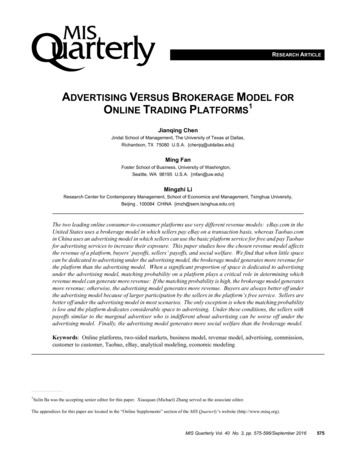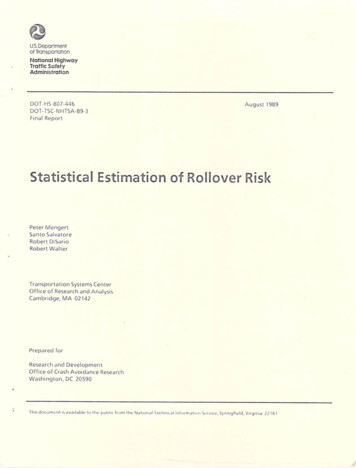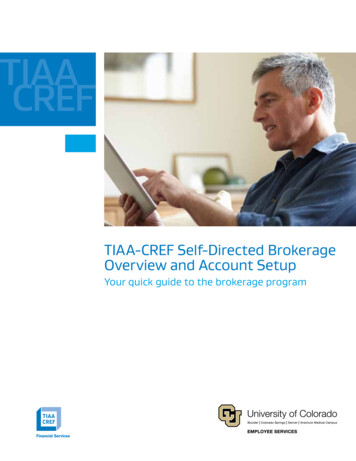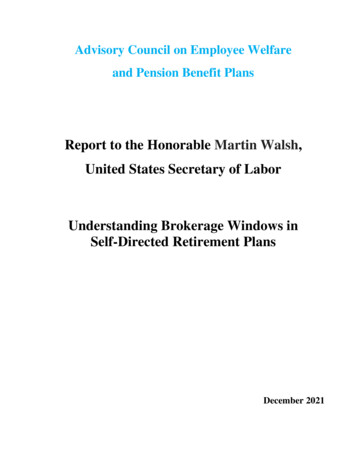
Transcription
RESEARCH ARTICLEADVERTISING VERSUS BROKERAGE MODEL FORONLINE TRADING PLATFORMS1Jianqing ChenJindal School of Management, The University of Texas at Dallas,Richardson, TX 75080 U.S.A. {chenjq@utdallas.edu}Ming FanFoster School of Business, University of Washington,Seattle, WA 98195 U.S.A. {mfan@uw.edu}Mingzhi LiResearch Center for Contemporary Management, School of Economics and Management, Tsinghua University,Beijing , 100084 CHINA {imzh@sem.tsinghua.edu.cn}The two leading online consumer-to-consumer platforms use very different revenue models: eBay.com in theUnited States uses a brokerage model in which sellers pay eBay on a transaction basis, whereas Taobao.comin China uses an advertising model in which sellers can use the basic platform service for free and pay Taobaofor advertising services to increase their exposure. This paper studies how the chosen revenue model affectsthe revenue of a platform, buyers’ payoffs, sellers’ payoffs, and social welfare. We find that when little spacecan be dedicated to advertising under the advertising model, the brokerage model generates more revenue forthe platform than the advertising model. When a significant proportion of space is dedicated to advertisingunder the advertising model, matching probability on a platform plays a critical role in determining whichrevenue model can generate more revenue: If the matching probability is high, the brokerage model generatesmore revenue; otherwise, the advertising model generates more revenue. Buyers are always better off underthe advertising model because of larger participation by the sellers in the platform’s free service. Sellers arebetter off under the advertising model in most scenarios. The only exception is when the matching probabilityis low and the platform dedicates considerable space to advertising. Under these conditions, the sellers withpayoffs similar to the marginal advertiser who is indifferent about advertising can be worse off under theadvertising model. Finally, the advertising model generates more social welfare than the brokerage model.1Keywords: Online platforms, two-sided markets, business model, revenue model, advertising, commission,customer to customer, Taobao, eBay, analytical modeling, economic modeling1Sulin Ba was the accepting senior editor for this paper. Xiaoquan (Michael) Zhang served as the associate editor.The appendices for this paper are located in the “Online Supplements” section of the MIS Quarterly’s website (http://www.misq.org).MIS Quarterly Vol. 40 No. 3, pp. 575-596/September 2016575
Chen et al./Advertising vs. Brokerage Model for Online Trading PlatformsIntroductioneBay.com, the leading online consumer-to-consumer platformin the United States, has been establishing its business for twodecades. Individual buyers can shop on the eBay platformwithout any fee, and sellers pay eBay on a transaction basis.Arguably, eBay was one of the biggest innovations andsuccesses in the early e-commerce period. In contrast,Taobao.com, the leading online consumer-to-consumer platform in China, started its business in 2003. While Taobaoand eBay share many similar design features, Taobao adopteda radically different revenue model. In addition to providingfree service to individual buyers, Taobao offers the basic platform service to sellers for free as well. Meanwhile, Taobaooffers an advertising/promotion service to monetize thetraffic, and sellers can pay to participate. In other words, ina manner different from eBay but similar to Google searchresult pages, Taobao provides two lists: One is an “organic”listing, typically on the left of each page, in which sellers arelisted for free, and the other is a “paid” listing, typically onthe right of each page, in which sellers pay Taobao to increasetheir exposure to potential buyers. The differences betweenthe revenue models associated with the two largest and mostsuccessful online marketplaces raise several questions:Which revenue model is more suitable for an online platform?How should a platform choose and design a revenue model?How does the revenue model affect buyers’ and sellers’payoffs? This paper aims to answer these questions.Founded in 1995, eBay’s total transaction volume, or grossmerchandise volume, was nearly 62 billion in 2010, according to its annual report. eBay’s marketplace chargessellers insertion fees and final value fees. The insertion feeranges from 0.10 to 2 for auction-style listings at eBay andis 0.50 for fixed-price listings. Depending on the sale formatand product category, the final value fees at eBay can rangefrom 7 percent to 13 percent of the total buyer cost, includingprice and shipping costs.2 Taobao was launched by AlibabaGroup in 2003 and has grown remarkably since then. Its salesvolume was about 61 billion in 2010.3 Taobao offers basicmarket services for free to both buyers and sellers. Its mainsource of revenue is the advertising paid for by the sellers.Despite the success of Taobao, no formal analysis of itsrevenue model has been conducted. This study fills this gapand sheds some light on the choice and design of revenuemodels for a platform.To do so, we develop a game-theoretic model in which a platform faces a group of potential buyers on the one side and agroup of potential sellers on the other. We assume the platform can choose either the brokerage model or the advertisingmodel. Under the brokerage model, the platform chargessellers a transaction fee for each sale. Under the advertisingmodel, the platform offers the basic service for free and,meanwhile, provides paid advertising service in which sellerscan participate to increase their exposure. The choice of therevenue model for a platform affects potential sellers’ participation decisions. Potential buyers pay nothing to participatebut have different opportunity costs in using the platform.Buyers’ participation decisions are affected by the number ofparticipating sellers and the matching probability. The number of participating sellers indicates the likelihood that abuyer’s trading partner is on the platform: As more sellersparticipate in the platform, that likelihood increases. Thematching probability measures the likelihood of a buyeractually finding his or her trading partner (given the partnerbeing on the platform). Using this framework, we comparethe revenues of the platform, sellers’ payoffs, buyers’ payoffs,and social welfare under the two revenue models.We identify both the space dedicated to advertising and thematching probability as key factors in comparing the tworevenue models. Not surprisingly, when little space can bededicated to advertising under the advertising model, thebrokerage model generates more revenue for the platform thanthe advertising model. When a significant proportion of spaceis dedicated to advertising under the advertising model,matching probability on a platform plays a critical role indetermining which revenue model can generate more revenue:If the matching probability is high, the brokerage modelgenerates more revenue; otherwise, the advertising modelgenerates more revenue. In the presence of a free basicplatform service, when the matching probability is low, theadvertising space becomes more valuable, which allows theplatform to charge a higher price and potentially to makemore revenue under the advertising model.Buyers are always better off under the advertising modelbecause of greater participation by sellers in the platform’sfree service. Sellers are better off under the advertising modelin most scenarios. The only exception is that, when thematching probability is low and the platform dedicates a largespace to advertising, the sellers having payoffs similar to themarginal advertiser (i.e., the advertiser who is indifferentabout advertising) can be worse off under the advertisingmodel. Finally, the advertising model generates more socialwelfare than the brokerage model because of the increasednumber of trading 49.shtml.576MIS Quarterly Vol. 40 No. 3/September 2016Our study is mainly related to two streams of research. Thefirst related stream looks at different business and revenue
Chen et al./Advertising vs. Brokerage Model for Online Trading Platformsmodels. A number of papers focus on one type of revenuemodel and study the optimal strategies under that model(Anderson and Coate 2005; Casadesus-Masanell and Zhu2013; Cheng and Liu 2012; Niculescu and Wu 2014). Forexample, Anderson and Coate (2005) examine equilibriumadvertising levels in broadcasting, and Niculescu and Wu(2014) investigate when software firms should commercializenew products via freemium business models. Other paperscompare different revenue models. For instance, CasadesusMasanell and Zhu (2010) analyze the optimal business modelchoice for a high-quality incumbent facing a low-quality, adsponsored competitor in a product market. Among the fourbusiness models considered—a subscription-based model, anad-sponsored model, a mixed model incorporating both subscriptions and advertising, and a dual model in which oneproduct uses the ad-sponsored model and the other uses themixed model—they find the incumbent prefers the subscription-based or the ad-sponsored model. Lin et al. (2012) consider settings in which online service providers might offer anad-free service, an ad-supported service, or a combination ofthese services. They find that in a monopoly case, offeringboth ad-free and ad-supported services is optimal, and in aduopoly case, exactly one firm offers both services when thead revenue rate is sufficiently high. Our study differs fromtheirs in that we compare the advertising model and thebrokerage model for online trading platforms. In addition, inour setting, the basic platform service and the advertisingservice serve the same purpose of presenting relevant sellersto potential buyers and, by their nature, are substitutes; thus,our analysis and insights depart from theirs.The second related stream involves the studies on two-sidedmarkets (Bhargava and Choudhary 2004; Economides andKatsamakas 2006; Gallaugher and Wang 2002; Hagiu 2009;Jullien 2006; Parker and Alstyne 2005; Rochet and Tirole2003). Two-sided markets refer to the situations where “platforms” provide services to facilitate interactions and theoperation of exchanges between two types of trading partners(Jullien 2006). Examples of two-sided markets include creditcard systems (cardholders and merchants), health maintenanceorganizations (patients and doctors), shopping malls (buyersand merchants), travel reservation services (travelers andairlines), video game consoles (gamers and game developers),and online trading platforms (buyers and sellers). In a typicaltwo-sided market, the users’ benefit from joining the platformon one side is increasing in the number of users adopting theplatform on the other side. For example, in an online tradingplatform that provides services to enable interactions betweenbuyers and sellers (a two-sided market), users on one side(e.g., sellers) are more likely to find their trading partners ifmore users join the platform on the other side (e.g., buyers).Rochet and Tirole (2003) study platform competition andoptimal price allocation between buyers and sellers. Theyconsider a brokerage intermediary that charges prices or registration fees from market participants to be on a marketplace.The market has (indirect) network externalities, and thedemand on one side of the market depends on the demandfrom the other side. Bhargava and Choudhary (2004) studythe optimal quality and pricing strategies for informationintermediaries with aggregation benefits (positive indirectnetwork externalities) and find that intermediaries have strongincentives to provide quality-differentiated versions of theirservices. Gallaugher and Wang (2002) empirically investigate the effects on software price of different factors,including network externalities, in the context of the twosided market for web server software. In contrast to thesepapers, we compare two different revenue models for anonline trading platform and examine the effect of the revenuemodel choice of the platform on the players.Our research is also loosely related to the growing literatureon design science and mechanism design (e.g., Chellappa andShivendu 2010; Hevner et al. 2004; March and Storey 2008)in information systems. Researchers in information systemsnot only design and evaluate new systems in a business context (e.g., Chen et al. 2013; Nault and Dexter 2006), but alsodevelop new ways to conduct business to leverage the advancement of information technologies. For example, studieshave examined new trading mechanisms for distributedresource allocation (Guo et al. 2012), new business modelsfor the software industry (Niculescu and Wu 2014), anddifferent mechanisms for online personalization services(Chellappa and Shivendu 2010). The focus of this work is onunderstanding the effect on the individual users, platform, andsociety of different revenue model designs for an onlinetrading platform. Similar to other papers on design science,our paper is “aimed at improving the performance of businessorganizations” (March and Storey 2008, p. 725), but we focuson the revenue model of an online trading platform.The rest of the paper is organized as follows. In the nextsection, we set forth our baseline model. We then provide anequilibrium analysis, after which we compare the publisher’srevenue, buyers’ payoffs, sellers’ payoffs, and social welfareunder the two revenue models. We subsequently extend thebaseline model in various directions, showing that the qualitative results derived from the baseline model stay the samewhen buyers have heterogeneous search skills, when the totalexposure level under the advertising model is slightly different from that under the brokerage model, when buyers areaverse to advertising, and when sellers compete with eachother. In addition, we provide some discussion about platform competition and dynamics. In the final section wepresent our conclusions.MIS Quarterly Vol. 40 No. 3/September 2016577
Chen et al./Advertising vs. Brokerage Model for Online Trading PlatformsThe Baseline ModelWe consider an online platform with multiple sellers on oneside and multiple buyers on the other. The platform providesmatching as well as other necessary services to facilitatetransactions between sellers and buyers. Consistent withpopular online platform practices, such as in eBay and inTaobao, buyers can participate without any cost. We considertwo different revenue/business models for sellers: a brokerage model and an advertising model. Under the brokeragemodel, sellers pay a transaction fee τ for each sale. Under theadvertising model, sellers can participate in the basic platformservice for free, and, in addition, they can pay θ to participatein an advertising or promotion service provided by the platform to increase their exposure to potential buyers. Thebrokerage model resembles eBay’s practice, and the advertising model resembles Taobao’s practice.A mass of sellers with measure 1 may sell their productsthrough the platform. Consistent with the many existingstudies on two-sided markets (e.g., Jullien 2006), each selleris seen as selling a different product, and thus the competitionamong sellers is not considered in the baseline model. Sellershave different fixed costs, k, of providing their productsthrough the platform. A mass of buyers with measure 1 maybuy products through the platform. As in Jullien (2006), weassume that accessing the platform involves different opportunity costs, c, for the buyers. The opportunity cost can beviewed as, for example, the value that a buyer derives fromusing an alternative channel. Generally, the opportunity costmeasures the relative attractiveness of this platform to buyers,compared to the alternative channel that they may use. Weassume that both k and c satisfy uniform distributions withsupport [0, 1].Depending on their costs and the revenue model of theplatform, some buyers and sellers participate in the platformand others do not. We denote m as the mass of buyers and nas the mass of sellers participating in the platform. Noticethat both m and n are endogenously determined based onusers’ self-section behavior, and their values vary under thetwo revenue models. A buyer’s probability of finding hertrading partner on the platform depends on whether her sellingpartner is on the platform, and, if so, whether the buyer canfind the selling partner. In general, as the number of sellersparticipating in the platform increases, so does the likelihoodthat a buyer’s trading partner is on the platform. We assumethat the probability that a buyer’s trading partner is on theplatform is equal to the mass of participating sellers, n. Thisassumption simplifies the mathematical expressions whilecapturing the essential idea that a buyer’s trading partner ismore likely to be on the platform if more sellers participate inthe platform, as has been used often in the existing literature578MIS Quarterly Vol. 40 No. 3/September 2016(e.g., Jullien 2006). This assumption can also be understoodas each buyer has one unique trading partner in the seller pooland the trading partners’ costs are independent. Therefore,the probability of a buyer’s trading partner being on theplatform is the proportion of participating sellers out of theseller pool: n.Under the brokerage model, we assume that sellers are listedwithout differentiation, and each seller receives the sameexposure level p, which determines the likelihood that herproduct is noticed by buyers. In other words, a buyer can findher trading partner or the ideal product that meets her needwith probability p, p (0, 1), conditional on the partner’sbeing on the platform. For ease of exposition, we simplyassume that the trade occurs when a potential buyer finds hertrading partner or ideal product. Introducing a tradingprobability or a conversion rate adds an additional parameterwithout changing the results. We call p the buyer’s baseprobability of finding the ideal product, or the matchingprobability. The base probability depends on the quality ofthe search function provided by the platform and buyers’overall online skill and experience, among other factors.Notice that even with a powerful platform search function,buyers may not be able to find their ideal products. As in atypical product “discovery” process, buyers are often not surewhat product ideally meets their needs. Therefore, whenbuyers explore products on the platform, even if their idealproducts are on the platform, they might not be able to locatethem, because of the limited number of searches they conduct(Johnson et al. 2004) due to positive search cost (Stahl 1989).In the extension, we also consider the case in which buyershave heterogeneous search skills.Under the advertising model, advertised sellers get moreexposure than unadvertised ones and their products are morelikely to be noticed by potential buyers. If we denote p1 as theexposure that an unadvertised seller receives and p2 as theexposure that an advertised seller receives, we generally havep1 p2. We denote n' as the mass of sellers who participatein the advertising service. For the purpose of a fair comparison, we assume that, were the numbers of participating sellersunder the two revenue models the same, the total exposureunder the advertising model (i.e., (n – n')p1 n'p2) shouldequal the total exposure under the brokerage model (i.e., np):(n – n')p1 n'p2 np(1)In other words, if the numbers of participating sellers underthe two revenue model were the same, compared with thebrokerage model, the advertising model would not increase orreduce the overall exposure. In a sense, advertising acts as anexposure reallocation device: The advertising shifts theexposure toward the advertised sellers from the unadvertised
Chen et al./Advertising vs. Brokerage Model for Online Trading Platformssellers. As a result, the products from advertised sellers aremore likely to be noticed by buyers than the products fromunadvertised sellers. In the extension, we also consider thecase in which the total exposure under the advertising modelis not equal to that under the brokerage model.Because p1 p2, by Equation (1), we have p1 p, and, withoutloss of generality, we can let p1 (1 – a)p, where a [0, 1]reflects the proportion of space dedicated to advertising. Forexample, when a 0, we have p1 p2 p, which indicates allsellers receive the same exposure and are equally likely to benoticed by potential buyers with the base matching probabilityp. Thus, this case is equivalent to the one in which noadvertising space is offered. By simple algebra, from Equation (1), we can derivep2 p1 apnn′(2)which measures the additional exposure gained from advertising. Clearly, a larger space dedicated to advertising (i.e., alarger a) increases the additional exposure, given the numberof sellers who participate in the advertising service. By substituting in p1, we have p2 (1 – a)p (apn)/n'. Whenconsiderable space is dedicated to advertising (i.e., a is large)or when a relatively small number of sellers participates in theadvertising service (i.e., n'/n is small), p2, as previouslydefined, may technically go above 1. In this case, the advertised sellers are “overexposed” to buyers—they are noticed bypotential buyers with probability 1, and in fact are exposedmore than is necessary for them to be noticed by potentialbuyers with probability 1. We call this case excessive advertising. Therefore, while an unadvertised seller is noticed bybuyers with probability p1, an advertised seller is noticed bybuyers with probability min{p2, 1}. We call the case with p2 1 regular advertising. In the regular advertising case,Equation (1) can also be interpreted to mean that the(weighted) average matching probability is the same under thetwo revenue models. In the excessive advertising case, someattention from buyers is wasted, and the (weighted) averagematching probability in this case is lower than that underregular advertising.We denote s as the expected surplus that a buyer derives fromfinding her trading partner and π as the expected revenue thata seller derives from finding her trading partner. We assumes 1 and π 1 to exclude some less interesting cases. Forinstance, if π 1, under the advertising model, all sellersparticipate in the basic platform service (because their fixedcosts, being in the range [0, 1], are less than π) and the massof participating sellers is simply 1.Under the brokerage model, a buyer’s expected payoff fromparticipating in the platform isnps – c(3)and a seller’s expected payoff from participating in theplatform ismp(π – k – τ)(4)where k is the seller’s fixed cost and τ is the transaction feepaid to the platform.Under the advertising model, a buyer’s expected payoff fromparticipating in the platform is[(n – n')p1 n'min{p2, 1}]s – c(5)where [(n – n')p1 n'min{p2, 1}] is the probability that thebuyer can find her trading partner—the probability of findingthe partner among the unadvertised sellers plus the probabilityof finding the partner among the advertised sellers. Noticethat when p2 1, the above equation is simply (nps – c)because of Equation (1).A seller’s expected payoff from participating in the platformism[p1 I(min{p2, 1} – p1)](π –k) – Iθ(6)where I {0, 1} indicates whether the seller participates inthe advertising service. When the seller chooses not to participate in the advertising service (i.e., I 0), the seller’s expected payoff from participating in the platform is m p1(π – k).When the seller chooses to participate in the advertisingservice (i.e., I 1), the seller’s expected payoff fromparticipating in the platform is [mmin{p2, 1}(π – k) – θ]. Thebenefit of participating in the advertising service is the additional exposure (min{p2, 1} – p1), at the cost of θ.The sequence of events in the game is as follows. First, theplatform owner announces its revenue model and fee structure(i.e., transaction fee τ under the brokerage model or advertising fee θ under the advertising model). Then, the potentialsellers and buyers decide whether to participate in the platform simultaneously (which determines n and m, respectively). Under the advertising model, at the same time theparticipating sellers decide whether to participate in theadvertising service (which determines n'). Finally, transactions take place between sellers and buyers. Table 1 summarizes the main notations used in the paper.MIS Quarterly Vol. 40 No. 3/September 2016579
Chen et al./Advertising vs. Brokerage Model for Online Trading PlatformsTable 1. Summary of NotationsNotationDefinition and Commentsτtransaction fee for each sale under the brokerage modelθadvertising fee under the advertising modelkseller’s cost of providing a productcbuyer’s opportunity costmmass of participating buyersnmass of participating sellerspexposure that each participating seller receives under the brokerage model, also called “matching probability”p1exposure that each participating but unadvertised seller receives under the advertising modelp2exposure that each advertised seller receives under the advertising modeln'mass of sellers who participate in the advertising service under the advertising modelaproportion of space dedicated to advertising under the advertising modelsbuyers’ expected surplus from tradingπsellers’ expected revenue from tradingWe next derive and compare the equilibrium outcome underthe brokerage and advertising models, considering the complete parameter space of advertising space a and matchingprobability p.Equilibrium AnalysisIn this section, we examine the participation decisions of thepotential buyers and sellers in equilibrium, and we derive theequilibrium payoffs of both participating players and theplatform under the brokerage model and under the advertisingmodel.Equilibrium Under the Brokerage ModelGiven the structure of the problem, we can expect monotonicity in both the sellers’ and the buyers’ participationdecisions because the players with lower costs generallyderive higher payoff than their counterparts with higher costs.Specifically, if a buyer (seller) with a certain cost participatesin the platform, the buyers (sellers) with lower costs alsoparticipate. We summarize this observation in Lemma 1 withthe proof in the appendix.Based on this monotonicity, we next can characterize themarginal buyer who is indifferent about participating. Wedenote cB as the cost of the marginal buyer, which satisfiesnps – cB 0, based on the payoff in Equation (3). By themonotonicity, the buyers with costs lower than cB participate580MIS Quarterly Vol. 40 No. 3/September 2016in the platform and those with costs higher than cB do notparticipate. Because we assume that the opportunity costs ofbuyers are uniformly distributed over [0, 1], the mass ofparticipating buyers is m cB. Similarly, we denote kB as thecost of the marginal seller who is indifferent about participating; that is, mp(π – kB – τ) 0, based on the payoff inEquation (4). The sellers who have costs lower than kBparticipate in the platform, and thus the mass of participatingsellers is n kB. From these observations, we can derivekB π – τ(7)cB kBps (π – τ)ps(8)Clearly, τ should be less than π; otherwise, no sellersparticipate.Notice that the total number of transactions is the probabilitythat each buyer can find her trading partner times the numberof participating buyers; that is, the total number of transactions is mnp cBkBp. The owner of the platform maximizesits revenue, ΠB, by optimally choosing its transaction fee:max cB k B pτ max p 2 sτ (π τ ) 20 τ π0 τ πBy the first-order condition, we conclude the optimal solutionas follows:Proposition 1. The optimal transaction fee that the platform should charge is τ* π/3, and the maximum revenue is4 p sπ 27 .*B23
Chen et al./Advertising vs. Brokerage Model for Online Trading PlatformsProof. All proofs are in the appendix, unless indicatedotherwise.The above results are derived in a fashion similar to thebalance between price and demand. If the transaction fee τ(i.e., price) is high, the participating players and thus thenumber of transactions (i.e., demand) is low. The optimalvalue as derived is the result of the balance. Note that if thenumber of participating buyers was fixed (such that m was nota function of τ), the optimal transaction fee would be π/2 bymaximizing the revenue of the platform mp(π – τ)τ. In contrast, considering the effect of τ on the number of participatingbuyers via the number of participating sellers, or consideringthe two-sided market effect, the optimal transaction fee π/3 islower than when considering the effect of τ on the number ofsellers only. The lower transaction fee in the two-sidedmarket occurs because lowering the transaction fee not onlyincreases the number of participating sellers, but alsoincreases the number of participating buyers. This additionalbenefit induces the platform to lower the transaction fee.Based on the optimal transaction fee and Equation (7), themass of participating sellers in equilibrium is2nB* k B* π3(9)By Equation (8), the mass of participating buyers in equilibrium ismB* cB* 2psπ3(10)Thus, we can conclude the participation of sellers and buyersas follows:Corollary 1. Under the brokerage model, the sellers whohave costs in [0, kB*] and the buyers who have opportunitycosts in [0, cB*] participate in the platform in equilibrium.*B*B*By substituting n , m , and τ into Equations (3) and (4), wecan formulate the payoffs of the participating buyers and thepayoffs of the participating sellers in equilibrium.Equilibrium Under the Advertising ModelSimilar to the brokerage model, in the advertising model, wehave monotonicity in both sellers’ and buyers’ participationdecisions. In pa
Chen et al./Advertising vs. Brokerage Model for Online Trading Platforms models. A number of papers focus on one type of revenue model and study the optimal strategies under that model (Anderson and Coate 2005; Casadesus-Masanell and Zhu 2013; Cheng and Liu 2012; Niculescu and Wu 2014). For example, Anderson and Coate (2005) examine equilibrium











